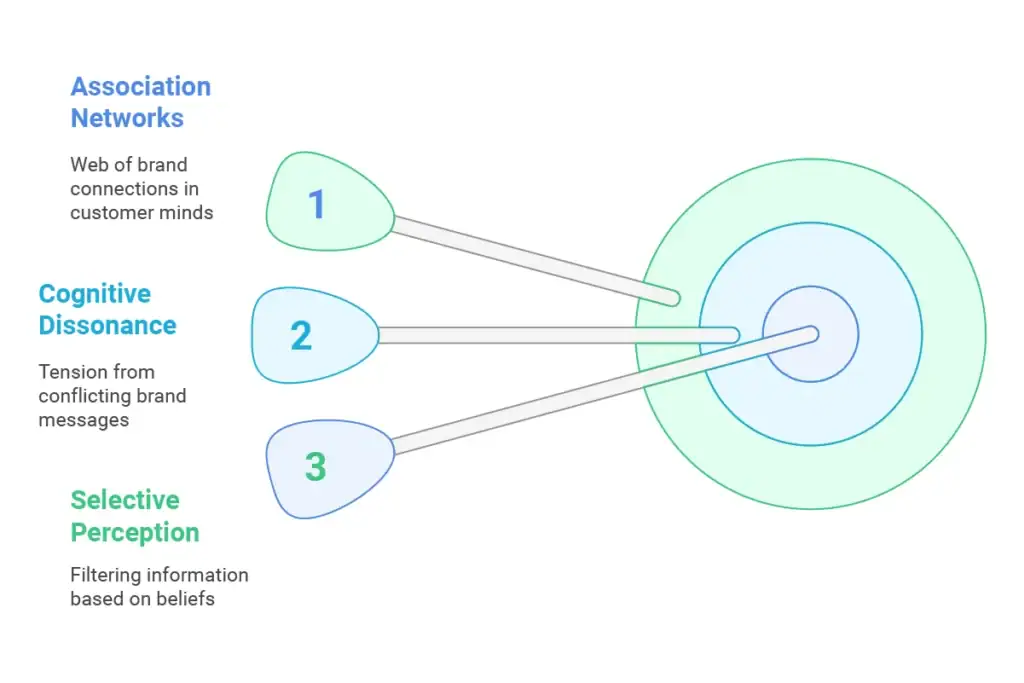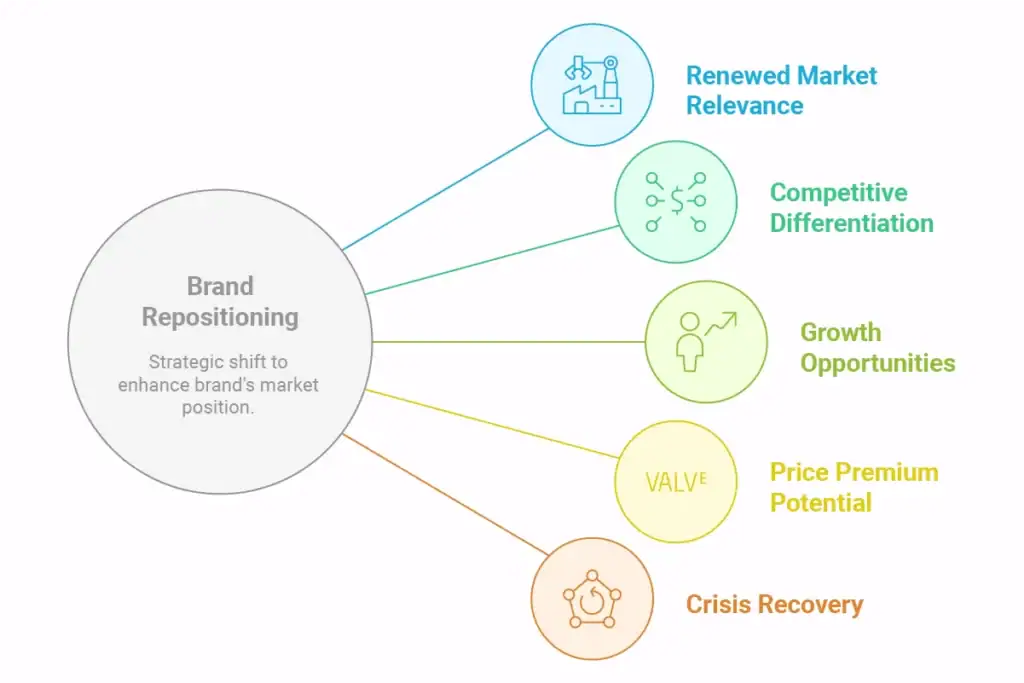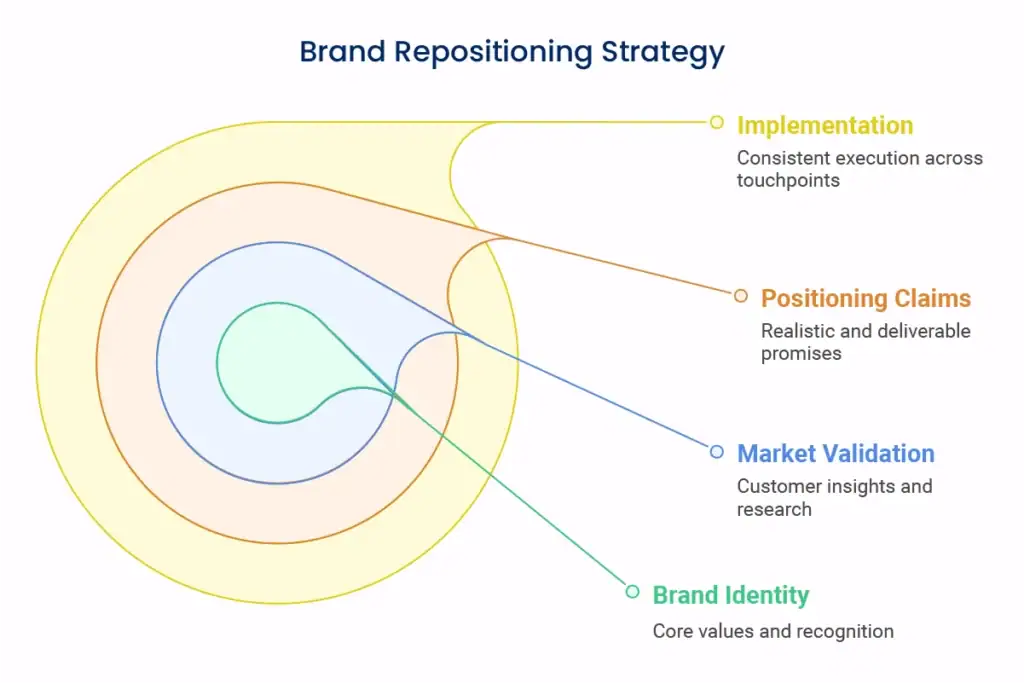Our Core Services
Brand Repositioning Mastery: Transforming Outdated Perceptions into Powerful New Market Positions Without Losing Your Core Identity
Are you fighting a dated brand image that no longer resonates with your target market? Maybe your company has changed, but your brand messaging hasn’t caught up? Brand repositioning provides a strategic way to update your market position without forfeiting the equity you’ve worked years to build.

Table of Content
What is Brand Repositioning?
Brand repositioning is the deliberate process of modifying the perception of how your brand is viewed in the marketplace without giving up its fundamental identity. As opposed to an overhaul of rebranding, repositioning refines particular aspects of your brand strategy to more closely align with existing market forces, consumer demands, or business objectives.
Picture it like renovating your house instead of relocating to a new one. You retain the frame and foundation but reshuffle to accommodate changing needs and tastes.
The difference between brand repositioning and other brand evolution methods is its specific strategy. While rebranding could update all the aspects of a brand from name to visual, brand repositioning is specifically aimed at the strategic place your brand is in the competitive map as well as in people’s minds.
The Psychology Behind Effective Repositioning

Effective brand repositioning operates on these core psychological principles:
Selective perception
Shoppers screen out information which does not fit previous beliefs, so gradual repositioning tends to be more successful than drastic ones
Cognitive dissonance
If brand messages contradict current beliefs, customers feel uncomfortable tension they want to eliminate
Association networks
Brands are webs of linked associations in customers' minds; repositioning alters these links instead of deleting them
Why Brand Repositioning Matters for Your Business

Brand repositioning is much more than a marketing exercise—it’s a business-imperative plan that can breathe new life into your organisation. Here’s why it’s important:
Revised market relevance
Makes new points of difference when market saturation undermines your position
Competitive differentiation
Makes new points of difference when market saturation undermines your position
Growth opportunities
Paves the way for new customer segments previously out of reach
Price premium potential
Repositions from commodity to value-based, enabling higher margins
5 Warning Signs Your Brand Needs Repositioning
It’s as crucial to know when to reposition your brand as to know how. These are the telltale signs your brand may require strategic repositioning:
Slipping relevance scores
If brand tracking research demonstrates declining relevance scores, or social listening observes your brand being discussed less often in category discussions, your position is losing relevance.
Shifting customer bases
If your target customer base is ageing without being replaced by new, younger consumers, or if customer profiles are moving out of your target segments, your positioning can no longer speak to the market you must reach.
Market disruption
As new entrants come in with disruptive models, or technological changes radically alter how customers interact with your category, your positioning can suddenly feel stale or irrelevant.
Merger or acquisition activity
After M&A, your combined organisation tends to need brand repositioning to prevent confusion and to make the improved value proposition of the merged organisation clear.
The best-performing brand repositioning efforts start before warning signs become crises. Ongoing brand health tracking allows identifying early signs that change is required.
Key Frameworks for Effective Brand Repositioning
Brand repositioning is far more than a marketing exercise—it’s a business-critical strategy that can breathe new life into your organisation. Here’s why it matters:

1. The Perception-Reality Gap Analysis
It centers on the measurement of disconnects between what you internally think your brand is and what customers actually feel it is. This allows you to aim repositioning efforts at precisely where there are misconceptions.
It is highly beneficial for small businesses since it optimizes scarce marketing budgets by aligning them solely with those aspects that truly require repositioning without trying a complete overhaul of the brand.
Its use involves a systematic process:
Internal assessment
Collect employee and leadership opinions on your brand's market position, key attributes, and strengths
External research
Collect customer and market data to gauge real perceptions
Gap mapping
Map out a visual representation of where perceptions differ and overlap
Prioritisation
Prioritize gaps according to strategic value and feasibility of bridging
This model is particularly effective for brands that have wandered away from their planned positioning incrementally over the years in the absence of strategic direction.
2. The Competitive Whitespace Model
This strategy breaks out empty spaces in your market where customer demand is still underserved. Instead of directly competing with incumbents, this model assists brands in identifying unique grounds they can solely claim.
For small organizations fighting against industry titans, the whitespace model provides an accessible means of shifting towards desirable niches where large competitors are inflexible or unfocused.
The model proceeds as follows:
Extensive competitor analysis
Plot competitors along major positioning variables
Customer needs analysis
Determine unmet or underserved market needs
Capability assessment
Assess your organisation's distinctive capabilities that may meet these needs
Whitespace discovery
Discover overlap points between unmet needs and your distinct capabilities
This structure is especially potent for brands in saturated markets that desire differentiation without invoking enormous resource commitments.
3. The Core-Flex Framework
This balanced strategy separates your brand’s fixed core elements (values, mission, heritage) from repositionable elements (messaging, visual identity, customer experience touchpoints).
This approach is particularly valuable for well-established brands with high equity, as it offers a structured way to update market image without tainting the genuine identity that loyal customers hold in esteem.
The process entails:
Core identification
Identify the critical components that define your brand as distinctly what it is
Flex mapping
Map brand components that can change without sacrificing core identity
Evolution planning
Plan how to evolve flexible components to underpin new positioning
Continuity preservation
Prepare explicit strategies to preserve and strengthen core components in transition
For heritage brands or brands with die-hard customer bases, this model provides an evolution that balances respect for brand heritage with the change that is required.
4. The Customer Evolution Alignment
This customer-led approach repositions your brand by observing the way the needs, behaviours and expectations of your audience have developed over time, and then repositioning your brand as a result.
For companies with customer churn or declining loyalty, this method can re-engage your brand with audiences whose agendas have changed but who remain interested in your core value proposition.
Implementation involves these stages:
Longitudinal analysis
Observe how customer needs and behaviours have altered over 3-5 years
Future forecasting
Anticipate ongoing development on the basis of new trends and indicators
Value proposition adaptation
Refine your value proposition to meet changing needs
Touchpoint adjustment
Adjust customer experience to meet new expectations
This structure is especially effective for brands within fast-evolving categories in which customer expectations change rapidly because of technology or social transformation.
Get expert optimization to convert more traffic into revenue.
Brand Repositioning Process: A Step-by-Step Guide
1. Recognise the Need for Change
The initial step is to seriously evaluate if repositioning is actually needed. Check for these warning signals:
- Fading applicability among target consumers
- Growing challenge distinguishing oneself from the competition
- Internal developments (new skills, mergers) that don’t find expression in your brand
- Continuous feedback that your brand looks dated
- Moving into new markets where your existing positioning isn’t resonating
If multiple of these signs occur, brand repositioning can be the right strategic adjustment. This awareness stage should involve the collection of quantitative information (sales trends, market share) as well as qualitative information (customer feedback, sales staff input).
2. Conduct a Comprehensive Brand Audit
Prior to making adjustments, deeply understand your existing brand position through:
- Brand perception studies among existing and prospective customers
- Competitive research to grasp positioning against alternatives
- Internal capability review to determine strengths that would enable new positions
- Historical brand analysis to recognize equities of worth to maintain
- Market trend analysis to spot emerging opportunities
This audit must be undertaken in an open-minded spirit of curiosity rather than confirmation bias, because its results might contradict current suppositions about your brand.
3. Define Your Repositioning Strategy
With audit findings in hand, craft a concise repositioning strategy consisting of:
- The exact perception changes you’re seeking to establish
- Definition of target audience (current and/or new)
- Key messages that will reinforce the new position
- Competitive frame of reference for your brand
- Unique value proposition in the new position
This strategy must be recorded in a concise brief that will inform all future creative and implementation work. The strategy must be detailed enough to offer direction but vague enough to permit creative interpretation in execution.
4. Conduct Stakeholder Alignment
Prior to external implementation, attain internal alignment through:
- Presenting the repositioning strategy to leadership for endorsement
- Developing communication materials to describe why change is necessary
- Responding to concerns of different stakeholder groups
- Seeking and integrating feedback as needed
- Defining measures for assessing repositioning effectiveness
This alignment process is essential to guarantee the repositioning transitions from planning into effective execution. In the absence of strong internal commitment, the external marketplace will not accept or believe your new stance.
5. Develop the Creative Expression
Translate your strategy into concrete expressions by way of:
- Revamped messaging platforms and brand narratives
- Revised visual identity elements (if necessary)
- New communication models and guidelines
- Updated customer experience touchpoints
- Content strategy developed to support the new position
Your creative development should be informed by your identity preservation framework so that valuable brand equities are not sacrificed in the transition.
6. Test with Key Audiences
Prior to full-scale rollout, test your new positioning through:
- Concept testing among target customer segments
- Feedback meetings with major clients or partners
- Internal critique with customer-facing teams
- Market tests on a small scale in limited channels
- Refinement based on initial reaction
Testing determines potential problems prior to full investment and increases confidence in your direction of repositioning. Be ready to make changes on the basis of feedback and not stick to initial concepts rigidly.
7. Create an Implementation Roadmap
Schedule the roll-out of your repositioning by:
- Prioritised schedule for refreshing various touch points of the brand
- Resource planning for implementation initiatives
- Employee and partner training programs
- Stakeholder communication strategy
- Synergy with other marketing and business initiatives
This roadmap should be balanced between desire for effect and realistic resource limitations. In most situations, a phased implementation is more effective than trying to change everything at once.
8. Launch and Reinforce
Implement your repositioning with:
- Internal launch to create comprehension and buy-in
- External launch communications to primary audiences
- Ongoing reinforcement through all channels
- Periodic check-ins to maintain implementation quality
- Early wins celebration to drive momentum
The launch is not the culmination but the commencement of your repositioning effort. Prepare for ongoing reinforcement of your new position instead of expecting a single announcement to be enough to drive the desired perception shift.
Common Brand Repositioning Mistakes and How to Avoid Them

Disconnecting from Core Identity
The Mistake: Certain organisations introduce such radical changes while repositioning that they lose the rich associations and relationships developed over years.
How to Avoid It: Establish a clear identity preservation system prior to initiating creative work. Determine which parts of your brand are central to recognition and trust, and then make sure these stay constant as other elements evolve. Try new ideas with current customers to make sure they continue to feel a genuine connection to your brand.
Insufficient Market Validation
The Mistake: Attempting to claim positions that your organisation cannot authentically deliver, creating a gap between promises and reality.
How to Avoid It: Make sure your internal capabilities truly enable your intended role. Make honest estimates of your capacity to fulfill new commitments. Construct implementation plans that cover operational change required to enable your new market position, rather than communication change.
Unrealistic Positioning Claims
The Mistake: Attempting to claim positions that your organisation cannot authentically deliver, creating a gap between promises and reality.
How to Avoid It: Make sure your internal capabilities truly enable your intended role. Make honest estimates of your capacity to fulfill new commitments. Construct implementation plans that cover operational change required to enable your new market position, rather than communication change.
Inconsistent Implementation
The Mistake: Shifting some brand touchpoints and retaining others that are connected to your previous positioning, causing confusion instead of clarity.
How to Avoid It: Audit every touchpoint with customers and develop an all-encompassing implementation plan. Prioritize high-impact touchpoints for an early refresh while developing a schedule to address all manifestations of your brand. Establish clear guidance that enables everyone to express the new positioning consistently.
Final Thoughts
Effective brand repositioning treads a fine line between healthy evolution and useful continuity. The best repositioning approaches recognize that your brand lives in customers’ minds, not only in your marketing communications.
By coming at brand repositioning with respect for the real strengths of your brand but also with a willingness to openly confront its weaknesses, you craft something mighty—a brand that is at once new and familiar. This equilibrium enables you to find new people without losing old fans who’ve stood by you since the start.
Keep in mind that repositioning is not an advertising strategy but rather a business imperative that should guide everything from product creation to customer support to hiring. If done thoughtfully, it builds fresh momentum and relevancy that can propel your brand for many years to come.
Need Help with Brand Repositioning?
If you’re thinking about repositioning your brand but don’t know where to begin, the advice of experts could prove invaluable. Professional branding services can guide you in determining which aspects of your brand need to change without losing the fundamental equity you’ve developed over time.
When looking for support with brand build strategy, seek out partners who have:
- Strategic acumen prior to creative action
- Solid research practice
- Cross-functional knowledge in communications and operations
- Successful implementation histories
- Cultural fit with your organisation
The right partnership transforms repositioning from a high-risk endeavour to a structured evolution that respects your brand’s heritage while boldly addressing its future.
